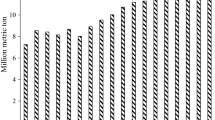Abstract
Seeds of the tribal pulse,Mucuna gigantea, were analysed for proximate composition, total (true) seed proteins, seed protein fractionation, amino acid composition, minerals and antinutritional factors. Crude proteins, crude lipids, ash and nitrogen free extractives constituted 30.62%, 9.03%, 5.99% and 42.79%, respectively. The calorific values of 100 g dry matter of seed material is 374.91 kCal. The essential amino acids, leucine +isoleucine, are present in relatively large quantities. The seeds are rich in minerals like K, Ca, Mg and Fe. Antinutritional substances like total free phenols and tannins, trypsin inhibitor activity and haemagglutinating activity also were investigated.
Similar content being viewed by others
References
Amubode FA, Fetuga BL (1983) Proximate composition and chemical assay of methionine, lysine, tryptophan in some Nigerian forest trees. Food Chem. 12: 67–72
Afolabi OA, Oshuntogun BA, Adewsi SR, Fabojuwo OO, Ayorinde FO, Grissom FE, Oke OL (1985) Preliminary nutritional and chemical evaluation of raw seeds fromMucuna solanei. An under utilised food source. J. Agric Food Chem 33: 122–124
AOAC (1970) Official Methods of Analysis. Washington DC: Association of Official Analytical Chemists
Arora RK, Chandel KPS, Joshi BS, Pant KC (1980) Rice bean: Tribal pulse of Eastern India. Econ Bot 34: 260–263
Basha SMM, Beevers L (1975) The development of proteolyic activity and protein degradation during germination ofPisum sativum L. Planta 124: 77–87
Basha SMM, Cherry JP, Young CT (1976) Changes in free amino acids, carbohydrates and proteins of maturing seeds from various peanut (Arachis hypogea L.) cultivars. Cereal Chem 53: 587–597
Brain KR (1976) Accumulation of L-DOPA in cultures fromMucuna pruriens. Plant Sci Letts 7: 157–161
Bray HG, Throne WV (1954) Analysis of phenolic compounds. Meth Biochem Anal 1: 27–52
Burns RR (1971) Methods for estimation of tannin in grainSorghum. Agron J 63: 511–512
Chrispeels MJ, Baumgartner B (1978) Trypsin inhibitor in mungbean cotyledons. Purification, characteristics subcellular localization and metabolism. Plant Physiol 61: 617–623
Dickman SR, Bray RM (1940) Colorimetric determination of Phosphate. Ind Eng Chem Anal Ed. 12: 665–668
Gunjatkar N, Vartak VD, Enumeration of wild legumes from Pune district, Maharashtra. J Econ Tax Bot 3: 1–9
Gupta K, Wagle DS (1978) Proximate composition and nutrivite value ofPhaseolus mungoreus, A cross betweenPhaseolus mungo andPhaseolus aureus. J Food Sci Technol 15: 34–35
Humphries EC (1956) Mineral composition and ash analysis. In: Modern Methods of Plant Analysis, Vol. 1. Berlin: Springer-Verlag, pp. 468–502
IARI (1971) Research Bulletin (New Series No. 6) IARI, New Delhi
Issac RA, Johnson WC (1975) Collaborative study of wet and dry techniques for the elemental analysis of plant tissue by Atomic Absorption Sepctrophotometer. J AOAC 58: 436
Jain SK (1981) Glimpses of Indian Ethnobotany. New Delhi, Bombay, Calcutta: Oxford and IBH Publishing Co.
Jambunathan R, Singh U (1980) Studies on Desi and Kabuli chickpea (Cicer arietinum) cultivars 1. Chemical composition. In: Proceedings of the International Workshop on Chickpea Improvement. ICRISAT, Hyderabad, India. Feb. 28–March 2, 1979
Jambunathan R, Singh U (1981) Grain quality of pigeonpea. In: Proceedings of the International Workshop on Pigeonpeas Vol. I. Patencheru, Hyderabad, Andhra Pradesh, India. Dec, 15–19, 1980
Janardhanan K (1982) Studies on seed development and germination inMucuna utilis Wall. ex Wt. (Papilionaceae) Ph.D. Thesis, Madras University, Madras, India
Janardhanan K, Lakshmanan KK (1985) Studies on the tribal pulse,Mucuna utilis. Chemical composition and antinutritional factors. J Food Sci Technol 22: 369–371
Jebadhas AW (1980) Ethnobotanical studies on some hill tribes of South India, Ph.D. Thesis, Madras University, Madras, India
Kaushik P (1984) Lectin from different parts of the seeds ofDolichos. Proc Indian Natn Sci Acad 50: 242–244
Khan KM, Jacobsen I, Eggum OB (1979) Nutritive value of some improved varieties of legumes. J Sci Food Agric 30: 394–400
Kortt AA (1988) Isolation and characterization of the lectin from the seeds ofPsophocarpus scandens. Phytochemistry 27: 2847–2855
Kotaru M, Ikeuchi T, Yoshikawa H, Ibuki F (1987) Investigation of antinutritional factors of the winged bean (Psophocarpus tetragonolobus). Food Chem 24: 279–286
Liener IE (1976) Phytohaemagglutinins (phytolectins). Ann Rev Plant Physiol 27: 291–316
Lowry OH, Rosebrough NJ, Farr AL, Randall RJ (1951) Protein measurement with folin phenol reagent. J Biol Chem 193: 265–275
Ologhogbo AD, Fetuga BL (1983) Investigation on the trypsin inhibitor, haemagglutinin, phytic and tannic acid contents of cowpea,Vigna unguiculata. Food Chem 12: 249–254
Osborne DR, Voogt P (eds) (1978) Calculation of calorific value. In: The Analysis of Nutrients in Foods. New York: Academic Press, pp. 239–240
Rao PV, Deosthale YG (1982) Tannin content of pulses, varietal differences and effects of germination and cooking. J Sci Food Agric 33: 1013–1016
Ravindran V, Ravindran G (1988) Nutritional and antinutritional chracteristics of Mucuna (Mucuna utilis) bean seeds. J Sci Food Agric 46: 71–79
Rabinson DR (1987) Food Biochemistry and Nutritional Value. Burnmill Haslow: Longman Scientific and Technol., pp. 327–328
Singh SP, Misra BK, Chandel KPS, Pant KC (1980) Major food constituents of rice bean (Vigna umbellata). J Food Sci Technol 17: 238–240
Sosulski FW (1983) Legume protein concentration by air clarification. In: Hudson BJF (ed.) Developments in Food Proteins, Vol. 2. London: Applied Science Publishers
Sumathi S, Pattabiraman TN (1976) Natural plant enzyme inhibition. Part II—protease inhibitors of seeds. Indian J Biochem Biophys 13: 52–56
WHO/FAO (1973) FAO, Energy and protein requirements. Report of Joint FAO/WHO Adhoc Expert Committee, Published by FAO/WHO, Rome, 1973
Author information
Authors and Affiliations
Rights and permissions
About this article
Cite this article
Rajaram, N., Janardhanan, K. The biochemical composition and nutritional potential of the tribal pulse,Mucuna gigantea (Willd) DC. Plant Food Hum Nutr 41, 45–51 (1991). https://doi.org/10.1007/BF02196381
Received:
Accepted:
Issue Date:
DOI: https://doi.org/10.1007/BF02196381




